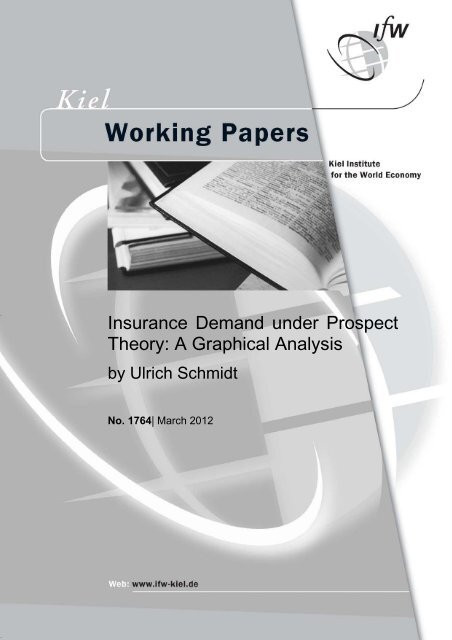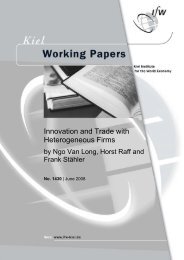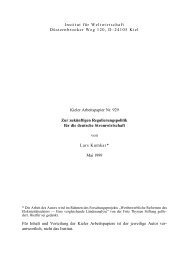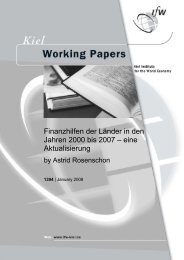Insurance Demand under Prospect Theory: A Graphical Analysis
Insurance Demand under Prospect Theory: A Graphical Analysis
Insurance Demand under Prospect Theory: A Graphical Analysis
Create successful ePaper yourself
Turn your PDF publications into a flip-book with our unique Google optimized e-Paper software.
<strong>Insurance</strong> <strong>Demand</strong> <strong>under</strong> <strong>Prospect</strong><br />
<strong>Theory</strong>: A <strong>Graphical</strong> <strong>Analysis</strong><br />
by Ulrich Schmidt<br />
No. 1764| March 2012
Kiel Institute for the World Economy, Hindenburgufer 66, 24105 Kiel, Germany<br />
Kiel Working Paper No. 1764|March 2012<br />
<strong>Insurance</strong> <strong>Demand</strong> <strong>under</strong> <strong>Prospect</strong> <strong>Theory</strong>: A <strong>Graphical</strong> <strong>Analysis</strong><br />
Ulrich Schmidt<br />
Abstract:<br />
Many people do not take up desaster insurance for their houses even though premiums are subsidized.<br />
A well-known example is flood insurance. At the same time they buy highly loaded insurance<br />
contracts for modest risk. Examples here are extended warranties or cellular phone insurance. This<br />
paper shows that unlike traditional decision theory prospect theory can explain this evidence provided<br />
the reference point is chosen in the right way<br />
Keywords:<br />
insurance demand, prospect theory, flood insurance, diminishing sensitivity, loss<br />
aversion<br />
JEL classification: D14, D81, G21<br />
Prof. Dr. Ulrich Schmidt<br />
Kiel Institute for the World Economy<br />
24100 Kiel, Germany<br />
Telephone:<br />
E-mail: Ulrich.schmidt@ifw-kiel.de<br />
____________________________________<br />
The responsibility for the contents of the working papers rests with the author, not the Institute. Since working papers are of<br />
a preliminary nature, it may be useful to contact the author of a particular working paper about results or caveats before<br />
referring to, or quoting, a paper. Any comments on working papers should be sent directly to the author.<br />
Coverphoto: uni_com on photocase.com
<strong>Insurance</strong> <strong>Demand</strong> <strong>under</strong> <strong>Prospect</strong> <strong>Theory</strong>:<br />
A <strong>Graphical</strong> <strong>Analysis</strong><br />
Ulrich Schmidt *<br />
Kiel Institute for the World Economy & Dept. of Economics, University of Kiel<br />
Abstract:<br />
This paper analyzes insurance demand <strong>under</strong> prospect theory in a simple model with two<br />
states of the world and fair insurance contracts. We argue that two different reference points<br />
are reasonable in this framework, state-dependent initial wealth or final wealth after buying<br />
full insurance. Applying the value function of Tversky and Kahneman (1992), we find that for<br />
both reference points subjects will either demand full insurance or no insurance at all.<br />
Moreover, this decision depends on the probability of the loss: the higher the probability of<br />
the loss, the higher is the propensity to take up insurance. This result can explain empirical<br />
evidence which has shown that people are unwilling to insure rare losses at subsidized<br />
premiums and at the same time take-up insurance for moderate risks at highly loaded<br />
premiums.<br />
JEL codes: D14, D81, G21<br />
Key words: insurance demand, prospect theory, flood insurance, diminishing sensitivity, loss<br />
aversion<br />
1 Introduction<br />
A major puzzle in insurance economics is the fact that people <strong>under</strong>insure low-probability<br />
events with high losses and overinsure moderate risks. It is well documented that many people<br />
do not take up disaster insurance even though premiums for such insurance contracts are often<br />
subsidized (Kunreuther et al., 1978; Kunreuther and Pauly, 2004). A very prominent example<br />
for this type of behavior is flood insurance in the USA. At the same time, for modest risk<br />
people do often buy insurance with premiums exceeding expected losses substantially<br />
(Pashigian et al.,1966; Drèze, 1981; Cutler and Zeckhauser, 2004; Kunreuther and Pauly,<br />
2006; Sydnor, 2010). Examples here are demand for low deductibles and markets for<br />
extended warranties or cellular-phone insurance. Beside the cited evidence from the field, also<br />
several experimental studies indicate that – holding loading factor and expected loss constant<br />
* I thank Peter P. Wakker for helpful comments. Address for correspondence: Ulrich Schmidt,<br />
Kiel Institute for the World Economy and University of Kiel, Düsternbrooker Weg 120,<br />
24105 Kiel, Tel.: +49 4318801400, Fax: +49 4318804621, email: ulrich.schmidt@ifw-kiel.de.<br />
1
– the rate of insurance take-up increases with the probability of the loss (Slovic et al., 1977;<br />
McClelland et al., 1993; Ganderton et al., 2000; but see also the contrary results of Laury et<br />
al., 2008).<br />
The standard theory of decision making <strong>under</strong> risk, expected utility (EU) theory, is not able to<br />
explain these phenomena. Under EU a subject will buy full insurance if and only if premiums<br />
are fair, i.e. equal expected losses. This excludes not taking up subsidized flood insurance or<br />
buying highly loaded cellular-phone insurance. Also fitting the demand for low deductibles to<br />
EU leads to implausible high degrees of risk aversion (Sydnor, 2010). While EU is primarily a<br />
normative theory of decision making <strong>under</strong> risk, also prospect theory (Kahneman and<br />
Tversky, 1979; Tversky and Kahneman, 1992) – currently one of the most prominent<br />
descriptive theory of decision making <strong>under</strong> risk – has not yet been successfully employed to<br />
organize the evidence. In fact, there exist only very few studies applying prospect theory (PT)<br />
to insurance demand. One reason for this may be the fact that it is not obvious what the right<br />
reference point for such an analysis should be. Usually the status quo is taken as reference<br />
point <strong>under</strong> PT. Accordingly, Wakker et al. (1997) and Sydnor (2010) take initial wealth – i.e.<br />
the wealth if no loss occurs – as reference point. The main problem, as argued by Sydnor<br />
(2010), is the fact that the decision to take up insurance is then determined entirely in the loss<br />
domain, where subjects are according to PT in general risk seeking. With overweighting of<br />
small probabilities, risk aversion for improbable losses can occur <strong>under</strong> PT, but also in this<br />
case the high demand for insuring modest risks cannot be explained.<br />
In the present paper we argue that it is questionable whether initial wealth is the right choice<br />
of the reference point for analyzing insurance problems with PT. Consider a simple insurance<br />
problem where the subject has initial wealth w but in one state of the world a loss L might<br />
occur such that final wealth equals w – L in this state. Wakker et al. (1997) and Sydnor (2010)<br />
take w as reference point. However, in fact the status quo is state-dependent in this example<br />
(it equals either w or w – L) and a new variant of PT proposed by Schmidt et al. (2008) allows<br />
for analyzing state-dependent reference points. Consequently, it seems reasonable to take w as<br />
reference point for the state without loss and w – L as reference point for the state in which<br />
the loss L occurs. Doing so implies that keeping the status quo (i.e. not taking up insurance)<br />
leads to neither gains nor losses in both states. The consequences for insurance demand with<br />
this reference point will be analyzed in section 3.1.<br />
Taking the status quo as reference point is, however, not necessarily the right choice from an<br />
empirical point of view. For instance, Hershey and Schoemaker (1985) and Bleichrodt, et al.<br />
(2001) found that people take one of the alternatives (usually a safe option) as their reference<br />
point and evaluated the outcomes of the other alternative relative to this reference point (see<br />
also Stalmeier and Bezembinder 1999, Morrison 2000, Robinson, Loomes, and Jones-Lee<br />
2001, van Osch et al. 2004). Since a safe alternative is available if subjects take up full<br />
insurance, final wealth after buying full insurance is also a reasonable reference point which<br />
will be explored in section 3.2.<br />
Before analyzing insurance demand we will introduce PT in the next section. As we wish to<br />
analyze insurance demand graphically, we particularly investigate the properties of PT´s<br />
indifference curves in two-outcome diagrams. We will also motivate why we refrain from<br />
2
taking into account probability weighting in the present analysis. Schmidt and Zank (2007)<br />
characterized insurance demand <strong>under</strong> PT with probability weighting and a piecewise linear<br />
value function. Contrary to the present analysis they take a reference point which lies between<br />
w and final wealth after buying full insurance. Apart from the already mentioned papers the<br />
only other paper analyzing insurance demand <strong>under</strong> PT is Eckles and Volkman Wise (2011).<br />
Here the reference point is different for each alternative, i.e. the reference point depends on<br />
the chosen level of insurance coverage. Although they analysis is behaviorally convincing,<br />
their model is indeed not compatible with PT as <strong>under</strong> PT all alternatives are evaluated <strong>under</strong><br />
the same reference point.<br />
Even in our simple model with fair insurance contracts, only two states of the world and no<br />
probability weighting PT in general does not allow to derive clear-cut implications for<br />
insurance demand. For both reference points we analyze optimal insurance demand is<br />
determined by trading off gains in one state with losses in the other state. As the value<br />
function of PT is concave for gains and convex for losses, it is not guaranteed that this tradeoff<br />
has an interior solution. Therefore, the bulk of our analysis is based on the specific<br />
functional form of the value function proposed by Tversky and Kahneman (1992) which is<br />
also employed in most empirical applications of PT. For this value function we show that no<br />
interior solution exists, i.e. subjects either buy full insurance or no insurance at all. In line<br />
with the evidence presented above, the propensity to take up insurance is increasing with the<br />
loss probability.<br />
2 <strong>Prospect</strong> <strong>Theory</strong><br />
PT was developed by Kahneman and Tversky (1979) and Tversky and Kahneman (1992) in<br />
order to accommodate empirical observed violations of EU. Compared to EU, PT introduces<br />
two main innovations, reference dependence and probability weighting. <strong>Insurance</strong> problems<br />
like disaster insurance are often concerned with rare events and both, the theory and the<br />
evidence for weighting probabilities of rare events is not entirely conclusive. In original PT<br />
for instance very small probabilities are either overweighted or rounded to zero. In order to<br />
circumvent this ambiguity and to keep the analysis simple we refrain from probability<br />
weighting in the present paper.<br />
For the graphical analysis we consider two-outcome diagrams with possible consequences x1<br />
and x2. If p is the probability of the first state, the PT value for any lottery in the two-outcome<br />
diagram is given by<br />
(1) V = pv(x1) + (1 – p)v(x2).<br />
The value function v with v(0) = 0 is defined on gains and losses measured as deviations from<br />
the reference point and not on final wealth positions as the utility function in EU. It is<br />
generally assumed that v satisfies diminishing sensitivity and loss aversion. Diminishing<br />
sensitivity means that marginal value is decreasing if one moves away from the reference<br />
point in either direction which implies that the value function is concave in the domain of<br />
3
gains and convex in the domain of losses. Loss aversion holds if the value function is steeper<br />
for losses than for gains, i.e. for x > 0 we have v’(-x) > v’(x).<br />
Empirical applications of PT often employ the following functional form of the value function<br />
proposed by Tversky and Kahneman (1992):<br />
� �� x if x�0 (1) v(x) � � �<br />
�� �� x if x�0. This value function, in the sequel referred to as K&T value function, exihibts diminishing<br />
sensitivity for � < 1 and loss aversion for � > 1. Median parameters observed in the<br />
experimental study of Tversky and Kahneman (1992) correspond to � = 0.88 and � = 2.25.<br />
For a graphical analysis of PT preferences we obviously need to know the curvature of<br />
indifference curves. As far as we know, this has not been analyzed yet in the literature. The<br />
slope of indifference curves can be approximated by<br />
dx (1 � p)v'(x )<br />
1 2<br />
(2) �� �0.<br />
dx2 pv'(x 1)<br />
It is well known from expected utility theory that indifference curves are convex if v is<br />
concave. However, for PT v is only concave in the gain domain but convex in the loss<br />
domain. Therefore, the curvature of indifference is ambiguous if one outcome is a gain and<br />
the other is a loss. To see this, suppose that x1 > 0 and x2 < 0. If we move along an<br />
indifference curve by increasing x2 and decreasing x1, both v’(x1) and v’(x2) are increasing as<br />
in both cases we move closer to the reference point. Therefore, the total effect on the slope in<br />
(2) is unknown without further assumptions on the shape of the value function. For the K&T<br />
value function we can get however more concrete results.<br />
Lemma 1:<br />
Consider a x1-x2 diagram and prospect theory with the K&T value function with � < 1 and �<br />
> 1. Then the indifference curve for a utility level V in the quadrant with x1 > 0 and x2 < 0 is<br />
convex (resp. linear, resp. concave) if V < (=, >) 0.<br />
Proof: See Appendix.<br />
3 <strong>Insurance</strong> <strong>Demand</strong><br />
In order to allow for an analysis in the two-outcome diagram we focus on a model with only<br />
two states of the world, in one of which a loss L will occur. Initial wealth is given by w such<br />
that in the absence of an insurance contract state-dependent wealth equals either w or w – L.<br />
We assume that the subject can buy coverage C, 0 � C � L, for the fair premium pC where p<br />
equals the probability of the loss. If insurance is taken up, final wealth equals w – pC if no<br />
loss occurs and w – L + (1 – pC) if the loss occurs.<br />
4
2.1 Status Quo as Reference Point<br />
In this section we analyze insurance demand with a state-dependent reference point given by<br />
the status quo, i.e. it equals either w or w – L. Therefore, if the subject refrains from taking up<br />
insurance there is a gain of zero in both states, i.e. the utility level equals zero (note that v(0)<br />
= 0 is always required in PT). For full insurance there is a gain of w – pL – (w – L) = (1 –<br />
p)L with probability p and a loss of w – pL – w = – pL with probability 1 – p. Table 1 gives<br />
an overview over the model.<br />
Utility when taking up insurance is given by<br />
(3) V = pv((1 – p)C) + (1 – p)v(–pC),<br />
Table 1: Status Quo as Reference Point<br />
which leads to the following first-order condition<br />
(4) p(1 – p)v‘((1 – p)C) – (1 – p)pv‘(–pC) = 0.<br />
Rearranging yields the condition for optimal coverage:<br />
(5) v‘((1 – p)C) = v‘(–pC).<br />
State No Loss Loss<br />
Probability 1 – p p<br />
Reference Point<br />
(Initial Wealth)<br />
This condition shows that an interior solution might not exist as in the case of diminishing<br />
sensitivity both v‘((1 – p)C) and v‘(–pC) are decreasing in C. Consistent with this observation<br />
the second-order condition<br />
(6) (1 – p)v‘‘((1 – p)C) + pv‘‘(–pC) < 0<br />
is not necessarily satisfied as v’’(– pC) > 0.<br />
w w – L<br />
Final Wealth w – pC w – L + (1 – p)C<br />
Gain/Loss – pC (1 – p)C<br />
In order to be able to derive concrete results we focus in the following on the K&T value<br />
function. According to equation (3), when deriving optimal insurance demand, the subject<br />
trades off a gain in one state with a loss in the other state. Lemma 1 shows that the sign of V<br />
5
determines the curvature of indifference curves for such cases. Inserting the K&T value<br />
function in (3) yields<br />
(7) V = p((1 – p)C) � – �(1 – p)� –pC � � .<br />
For any C > 0 this implies<br />
(8) V > (=, 0<br />
� ���α�<br />
leads to V < 0. Therefore, we have C = 0 for p < � ⁄<br />
� ���α�<br />
/�1 � � ⁄<br />
�. This case is<br />
depicted in the left panel of Figure 1. According to Lemma 1 the indifference curve for a<br />
� ���α�<br />
utility level of zero is linear here. The right panel shows the case where p > � ⁄<br />
/�1 �<br />
� ���α�<br />
� ⁄<br />
�. Here the indifference curve is concave since V > 0 and, therefore, full coverage is<br />
optimal. Note that when the indifference curve crosses the x1-axis from the left there is a kink<br />
due to loss aversion and it becomes convex since the value function is now concave for both<br />
outcomes. We can summarize our results in the following proposition.<br />
Proposition 1: For the K&T value function with � < 1 and � > 1 individuals who take the<br />
status quo as reference point will demand either full insurance or no insurance at all. Full<br />
� ���α�<br />
insurance will be taken up if p > � ⁄<br />
� ���α�<br />
/�1 � � ⁄<br />
�, no insurance is optimal for p <<br />
� ���α�<br />
� ⁄<br />
� ���α�<br />
/�1 � � ⁄<br />
�.<br />
Proposition 1 shows that the model is in principle compatible with the evidence that people do<br />
not take up insurance for low loss probabilities. However, for realistic values of � and � the<br />
condition in Proposition 1 leads to quite high probabilities. If we take the values of Tversky<br />
and Kahneman (� = 0.88 and � = 2.25) we get for instance p > 0,999, which means that<br />
subjects would take up insurance only for losses which are nearly certain.<br />
Full <strong>Insurance</strong><br />
-pL<br />
x1<br />
(1 – p)L<br />
No <strong>Insurance</strong><br />
x2<br />
.<br />
Full <strong>Insurance</strong><br />
-pL<br />
(1 – p)L<br />
No <strong>Insurance</strong><br />
Figure 1: Optimal insurance demand for status quo as reference point. Left panel: No<br />
coverage is optimal, right panel: full coverage is optimal<br />
x1<br />
6<br />
x2
2.2 Full <strong>Insurance</strong> as Reference Point<br />
As argued in in the introduction it is plausible that individuals take a safe option as reference<br />
point whenever it is available. For insurance demand the safe option is taking up full<br />
insurance. In this case w – pL is the final wealth and also the reference point in both states.<br />
When an individual decides upon optimal coverage she trades off gaining p(L – C), i.e. the<br />
saved premium, in the state without loss with loosing (1 – p)(L – C), i.e. the reduced<br />
compensation minus the saved premium, in the state with loss. Table 2 gives an overview<br />
over the model.<br />
Utility when taking up insurance is given by<br />
Table 2: Full <strong>Insurance</strong> as Reference Point<br />
(9) V = pv(– (1 – p)(L – C)) + (1 – p)v(p(L – C))<br />
which leads to the following condition for optimal coverage<br />
(10) v’(– (1 – p)(L – C)) = v’(p(L – C)).<br />
Again, an interior solution might not exist as both sides are increasing in C. As in the<br />
preceding section also the second order condition<br />
(11) (1 – p)v’’(– (1 – p)(L – C)) + pv’’(p(L – C)) < 0<br />
is not necessarily satisfied as the first summand is positive.<br />
In order to derive concrete results we have to go back to the K&T value function. For C = L,<br />
V obviously equals zero. If C < L is optimal we must have V > 0, i.e.<br />
(12) V = – �p� (– (1 – p)(L – C)� � + (1 – p)(p(L – C)) � > 0.<br />
Rearranging yields for any C < L<br />
State No Loss Loss<br />
Probability 1 – p p<br />
Reference Point w – pL w – pL<br />
Final Wealth w – pC w – L + (1 – p)C<br />
Gain/Loss p(L – C) – (1 – p)(L – C)<br />
7
1<br />
(13) V > (=, 0, C = 0 must be optimal<br />
� ���α�<br />
in this case. Figure 2 clarifies these results. In the left panel we assume p > 1/�1 � � ⁄<br />
�.<br />
This implies V < 0 for any positive coverage and hence full insurance is optimal. In the right<br />
� ���α�<br />
panel we have p < 1/�1 � � ⁄<br />
� which yields V > 0. According to Lemma 1 indifference<br />
curves are concave for V > 0 which implies that optimal coverage is given by zero.<br />
No <strong>Insurance</strong><br />
.<br />
Figure 1: Optimal insurance demand for full insurance as reference point.<br />
Left panel: full coverage is optimal. Right panel: no coverage is optimal<br />
The results of this section can be summarized in the following proposition.<br />
Proposition 2: For the K&T value function with � < 1 and � > 1 individuals who take final<br />
wealth after buying full insurance as reference point will demand either full insurance or no<br />
� ���α�<br />
insurance at all. Full insurance will be taken up if p > 1/�1 � � ⁄<br />
�, no insurance is<br />
� ���α�<br />
optimal for p < 1/�1 � � ⁄<br />
�.<br />
Applying the values of Tversky and Kahneman (� = 0.88 and � = 2.25) the condition for<br />
taking up insurance in Proposition 2 becomes p > 0,0012, i.e. only very rare risks will be<br />
uninsured. This value for p is however very sensitive to the value of �. For e.g. � = 0.5, which<br />
is also a quite realistic value, the condition would change to p > 0.165. Altogether, we can<br />
conclude that PT with full insurance as reference point provides a rather realistic<br />
accommodation of the evidence presented in the introduction.<br />
4. Conclusions<br />
- (1 – p)L<br />
x1<br />
pL<br />
Full <strong>Insurance</strong> x2<br />
No <strong>Insurance</strong><br />
- (1 – p)L<br />
Full <strong>Insurance</strong><br />
The present paper has considered insurance demand <strong>under</strong> PT in a simple model with fair<br />
insurance contracts and only two states of the world. In one variant of the model we<br />
considered the status quo as reference point which is state-dependent in the case of insurance<br />
problems. In a second variant we have argued that according to the evidence of Hershey and<br />
Schoemaker (1985) and Bleichrodt, et al. (2001) it is realistic that individuals may take final<br />
wealth after buying full insurance as their reference point. Employing the K&T value function<br />
x1<br />
pL<br />
x2<br />
8
we can show that in both variants of the model subjects do either buy full insurance or no<br />
insurance at all. Moreover, in both cases the propensity to take up insurance is increasing with<br />
the loss probability. Therefore, PT is in principle able to accommodate the evidence that<br />
people are unwilling to insure rare losses at subsidized premiums and at the same time take-up<br />
insurance for moderate risks at highly loaded premiums. The second variant of the model<br />
seems to be however more realistic as insurance will be taken up here already for relatively<br />
low probabilities.<br />
Appendix: Proof of Lemma 1<br />
An arbitrary utility level V in the two outcome diagram with x1 > 0 and x2 < 0 is given by<br />
(A1) V = px1 � – �(1 – p)� x2� � .<br />
Solving for x1 yields<br />
(A2) x1 = [(V + �(1 – p)� x2� � ) / p] 1/� .<br />
For constant V the slope of the corresponding indifference curve is given by the first<br />
derivative:<br />
(A3) dx1 / dx2 = – �[(1 – p) / p] � x2� �-1 [(V + �(1 – p)� x2� � ) / p] (1-�)/� ,<br />
and the curvature equals<br />
(A4) d 2 x1 / (dx2) 2 = (� – 1)�[(1 – p) / p] � x2� �-2 [(V + �(1 – p)� x2� � ) / p] (1-�)/� +<br />
This implies<br />
(A5) d 2 x1 / (dx2) 2 < (=, >) 0 �<br />
which yields<br />
(1 – �)[�[(1 – p) / p] � x2� �-1 ] 2 [(V + �(1 – p)� x2� � ) / p] (1-2�)/� .<br />
� x2� -1 – �[(1 – p) / p] � x2� �-1 [(V + �(1 – p)� x2� � ) / p] -1 > (=, ) 0 � �[(1 – p) / p] � x2� < (=, >) � x2� 1-� [(V + �(1 – p)� x2� � )] / p.<br />
Hence we get<br />
(A7) d 2 x1 / (dx2) 2 < (=, ) � x2� -� V + �(1 – p),<br />
which implies<br />
9
(A8) d 2 x1 / (dx2) 2 < (=, >) 0 � V > (=,
Schmidt, U., Starmer, C., and Sugden, R. (2008), “Third-Generation <strong>Prospect</strong> <strong>Theory</strong>,”<br />
Journal of Risk and Uncertainty 36, 203-223.<br />
Slovic , P. Fischhoff , B., Lichtenstein , S., Corrigan , B., and Combs, B. (1977), “Preferences<br />
for Insuring Against Probable Small Losses: <strong>Insurance</strong> Implications,” Journal of Risk and<br />
<strong>Insurance</strong> 44, 237-257.<br />
Sydnor, J. (2010), “(Over)insuring Modest Risks,” American Economic Journal: Applied<br />
Economics 2, 177-199.<br />
Tversky, A. and Kahneman, D. (1992), “Advances in <strong>Prospect</strong> <strong>Theory</strong>: Cumulative<br />
Representation of Uncertainty,” Journal of Risk and Uncertainty 5, 297-323.<br />
Wakker, P. P., Thaler, R. H., and Tversky, A. (1997), “Probabilistic <strong>Insurance</strong>”, Journal of<br />
Risk and Uncertainty 15, 7-28.<br />
11






